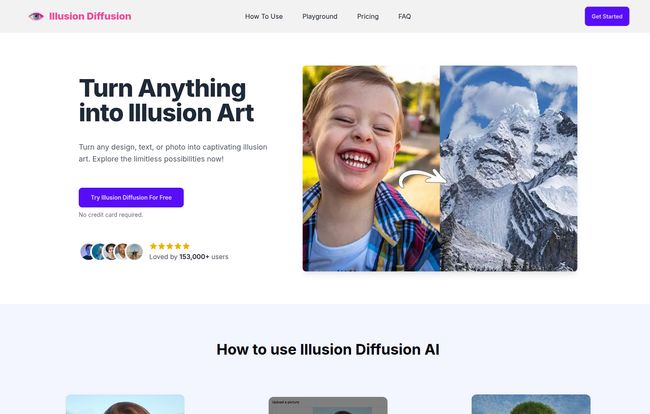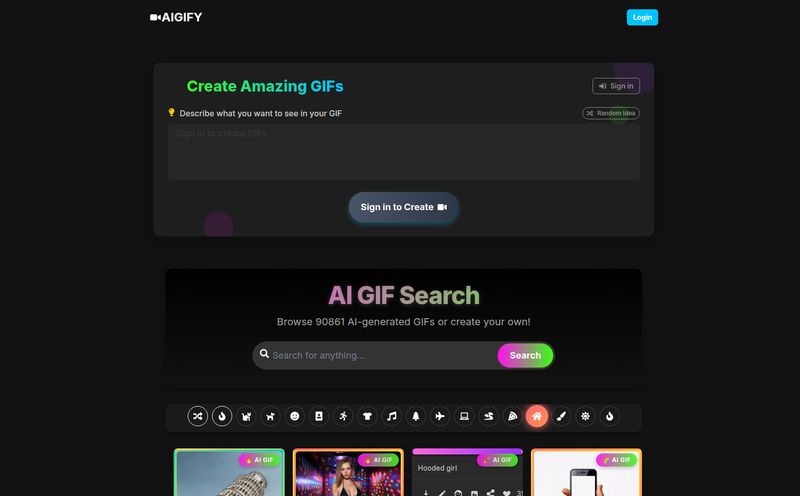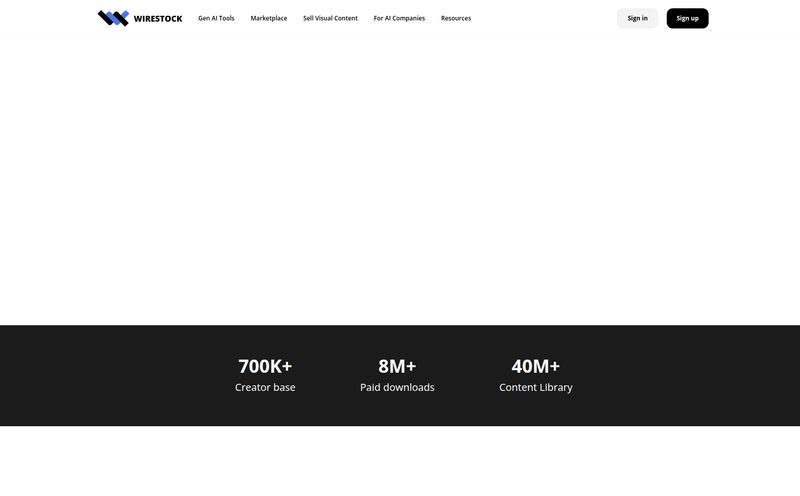Remember those Magic Eye posters from the 90s? You’d stare at a chaotic pattern until, pop, a 3D dolphin appeared, and you felt like a wizard. The internet’s latest obsession feels a bit like that, but supercharged for the modern age. I'm talking about AI-generated optical illusions, the kind of scroll-stopping images that make you do a double-take. And I’ve just been playing with a tool that makes creating them ridiculously easy: Illusion Diffusion AI.
For years, I've been deep in the trenches of SEO and traffic generation, and I can tell you, visual content that makes people stop and think is gold. Pure gold. We've seen the explosion of AI art with tools like Midjourney and DALL-E, but they can be... a lot. They're powerful, for sure, but sometimes you just want to do one cool thing without learning a whole new language of prompts. This is where I think Illusion Diffusion AI found its sweet spot.
So, What is Illusion Diffusion AI Exactly?
In a nutshell, Illusion Diffusion AI is a specialized online tool that takes a picture, a logo, or even just some text and weaves it into a new, complex image based on your text prompt. The original image isn't just pasted on top; its shape and form become the secret architecture of the final piece. Think of a portrait of a person where the lines of their face are actually formed by the crevices of a rocky canyon, or a brand name that appears to be made of clouds in the sky. It's clever, its eye-catching, and frankly, a little bit magical.
It's not trying to be the Swiss Army knife of AI image generation. It's a scalpel. And it’s incredibly good at its one specific, very cool job: making mind-bending illusion art.
Getting Started is Almost Too Simple
The biggest barrier to entry for a lot of AI tools is the learning curve. Illusion Diffusion AI seems to have side-stepped that completely. The process is genuinely as simple as they claim on their homepage. It’s a basic three-step dance:
- Upload Your Base Image: This can be anything. A selfie, a simple logo, a sketch you drew on a napkin. This is the hidden 'ghost' in your new machine.
- Write a Prompt: This is where you tell the AI what you want the new scene to be. Something like “A dense, magical forest at sunset” or “A bustling medieval city street.”
- Generate: Hit the button and wait a few seconds. The AI gets to work, merging your prompt with the structure of your uploaded image.
And that’s it. No complicated settings to fiddle with, no negative prompts to master, no code to worry about. Just upload, type, click. It's incredibly accessible.

Visit Illusion Diffusion AI
Putting It to the Test: My First Illusions
Of course, I had to try it myself. I grabbed a simple black and white logo I had lying around—just some abstract geometric shapes. For my prompt, I typed in “A vibrant coral reef teeming with fish.” I hit generate and held my breath.
The result? Pretty impressive. From a distance, it was a beautiful, colorful coral reef. But as you looked closer, you could clearly see the sharp, geometric lines of my original logo forming the edges of the coral formations and the shadows between them. It worked. It was fast, and it was genuinely cool. It’s the kind of thing you’d immediately want to share on social media, which from a marketing and traffic perspective, is exactly what you want.
I tried another one with a photo of my dog, a goofy golden retriever. The prompt was “A pile of autumn leaves in a park.” The resulting image was a beautiful fall scene, but the pattern of the leaves, the light and dark patches, perfectly mirrored the shape of my dog sitting. It’s addictive, I'm not gonna lie.
Beyond Selfies: What Can You Create?
While turning your face into a mountain range is fun, the applications for this are much broader, especially for content creators and marketers.
Turning Words into Worlds
The tool can take simple text and give it an artistic, illusory form. Imagine your brand's name, 'AURORA', not as plain text, but as an actual aurora borealis shimmering in the night sky. Or the word 'FRESH' appearing to be made of water droplets on a leaf. This is next-level visual branding. It turns a name or a message into a piece of art that tells a story all on its own.
Hiding Art in Everyday Scenes
This is the classic use case. For artists, it’s a new medium. For social media managers, it's a way to create engaging posts that encourage viewers to spend more time with your content. “Can you see the hidden face?” is a call to action that’s almost impossible to ignore. It’s playful, interactive, and highly shareable, which can do wonders for your organic reach.
A Quick Peek Under the Hood
For the geeks like me, you might be wondering how this actually works. The site mentions it's built on a pre-trained Stable Diffusion model, which is one of the powerhouses in the AI image space. The special sauce seems to be a process similar to what's known as ControlNet. It analyzes the input image to create a 'control map'—basically a blueprint of the core lines, shapes, and contrast. Then, it feeds this map and your text prompt into the AI, telling it, “Hey, create an image of a 'Japanese zen garden', but you have to make sure the core structure respects this blueprint.” The result feels like a collaboration between your prompt and your original image.
Let's Talk Money: The Illusion Diffusion Pricing
Okay, the fun part. How much does it cost to make this magic? Illusion Diffusion AI uses a credit-based system instead of a recurring monthly subscription. I've always had a love-hate relationship with credit systems, but here it kinda makes sense.
Here’s a quick breakdown of their one-time payment plans:
| Plan | Price | Credits | Validity |
|---|---|---|---|
| Starter | $7.9 | 40 | 1 Month |
| Basic | $9.9 | 100 | 1 Month |
| Advanced | $29.9 | 500 | 2 Months |
The good? No subscription trap. You buy what you need, which is great for specific projects. The bad? The credits expire, and they state that refunds aren't offered because of the server resources used for each generation. This is a critical point: use your credits wisely, because there are no do-overs if you don't like the result. This model is ideal for someone who needs a batch of images for a campaign but might not be great for someone who just wants to experiment endlessly without a goal.
The Good, The Bad, and The Arty
So, what’s the final verdict? I really like this tool. It's fast, fun, and creates something unique that other, more general AI generators struggle to produce without a lot of specific know-how. The ease of use is its biggest selling point. You can go from zero to a stunning optical illusion in under a minute.
On the flip side, the lack of refunds is a bit of a sting. If you burn through 10 credits on prompts that just don’t land right, that’s on you. The credit-based pricing also means you’re always aware of how many chances you have left, which can sometimes stifle that free-flowing creative process. It's a trade-off for the simplicity it offers.
Is Illusion Diffusion AI for You?
If you're a marketer, a social media content creator, or a designer looking for a new trick to pull out of your bag, then absolutely. The potential to create viral, engaging content is huge. It’s a fantastic tool for generating a specific type of high-impact visual quickly.
If you're a hardcore AI artist who wants granular control over every aspect of the generation process, this might feel a bit too simple for you. But even then, it's a fun and speedy way to brainstorm ideas. For its intended purpose, Illusion Diffusion AI nails it. It’s a reminder that sometimes the most powerful tools are the ones that do one thing perfectly.
Frequently Asked Questions
- How does Illusion Diffusion AI work?
- It uses a Stable Diffusion AI model combined with a control system. It takes the structure of an image you upload and uses it as a blueprint to create a new image based on your text prompt.
- Is Illusion Diffusion AI free to use?
- You can visit the site and see how it works without providing a credit card, but to generate and download images, you need to purchase a credit pack. There isn't an ongoing free plan.
- Can I use the images for commercial purposes?
- Typically, AI art generators allow commercial use of the images you create, but you should always check the platform's latest Terms of Service to be 100% certain, especially if using it for major brand campaigns.
- What happens if I don't like my generated image?
- Each generation costs a credit, whether you like the final result or not. The platform does not offer refunds for credits used, so it's best to be as clear as possible with your prompts.
- What kind of images work best as a starting point?
- In my experience, images with clear, strong shapes and good contrast work best. A clean logo or a well-lit portrait will likely give you a more recognizable illusion than a very 'busy' or low-contrast photo.
- Why does it use credits instead of a subscription?
- This pay-as-you-go model is often preferred by users who have project-based needs rather than a constant, daily requirement for the service. It avoids a recurring monthly charge.
Reference and Sources
- Illusion Diffusion AI Official Website
- Illusion Diffusion AI Pricing Page
- Stability AI (The makers of the underlying Stable Diffusion model)



